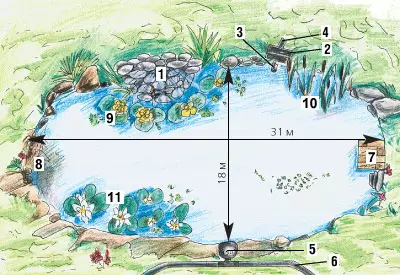
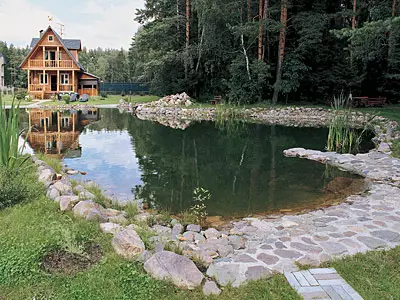
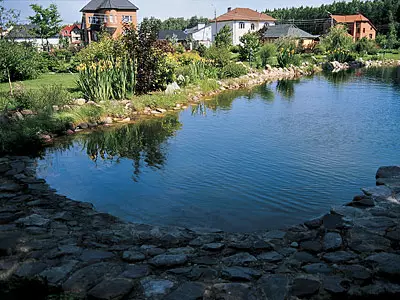
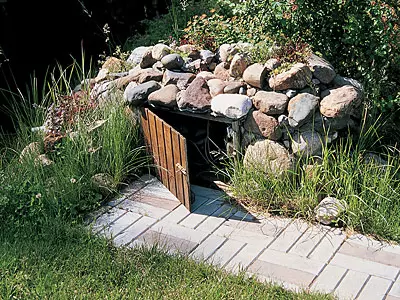
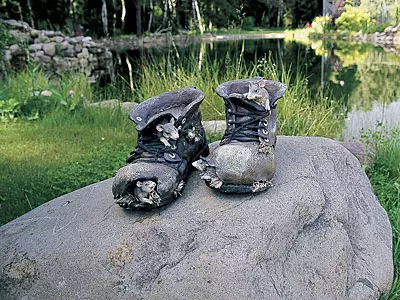
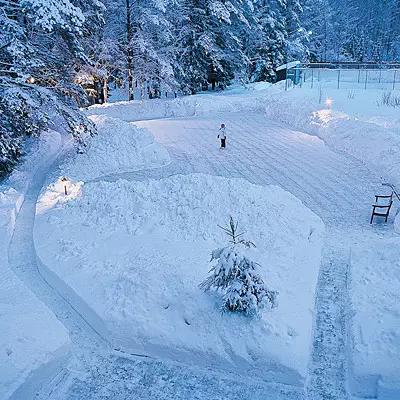
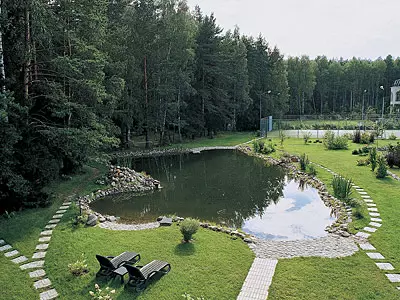
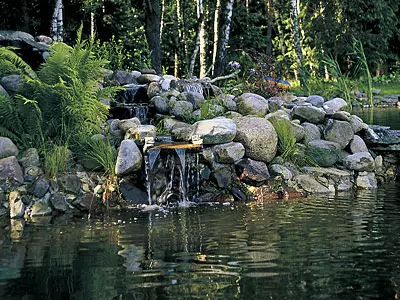
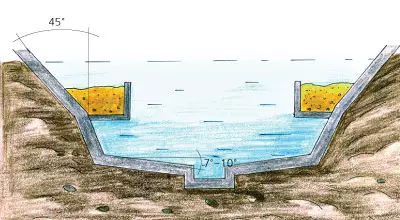
Contemplation of fixed water stroit is always soothing, instilling the thoughts about the serenity of being, eternity and inviolability of the world. That is why a small decorative pond increasingly becomes an integral part of the man-made landscape. In the artificial water branch, you can breed fish, arrange a fountain or even create a waterfall. Another thing, when I want to "redeem" in your own deep pond with a "live" running water. Our story about how to equip a reservoir.
More or less?
It is well known that water has a beneficial effect on the human body due to a unique combination of three properties: dissolve, flush and harden. In addition, the frozen water surface has long been used by us for sports purposes. For these reasons, a man-made pond, which was in question, was conceived not only as a picturesque element of the landscape with its unchanged sauming inhabitants, but also as an object of purely practical purpose. It makes it possible to refresh the hot summer day, go skating or play with neighbors in mini hockey in winter.For combining a pleasant with a useful, the pond is made decorative in shape, but quite large in the area and deep to ensure that the necessary biological balance is in it. The reservoir has the wrong outline: in its widest part of the coast, there are apart from each other at a distance of 31m, and in the narrow - 18m; The maximum depth reaches 3.5m. The volume of water in the pond is about 850m3. Only with such values of volume and depth can be divered from the shore without seas or swim from the mask and in the las.
A significant amount allowed the creation of optimal conditions for biocenosis. Initially, such a task was not put in front of them, but their previous experience in the arrangement of an artificial reservoir suggested that the pond was three times less than the necessary biological equilibrium. In general, it also helps to maintain a closely located area of the forest, the crowns of the trees of which protect the mirror of water from direct sunlight to four o'clock in the afternoon. It is for this reason that algae and bacteria are not so intensely multiply, and the aqueous plants dry and do not rot. The water temperature does not exceed 22 with even the hottest summer days and fluctuates in the range of 2-3 C.
How to make a deep pond?
First, it was pulled by a depth of approximately 4.2m (the final depth of the pond is 3.5 m). The walls of the hint at the depth of freezing are made with a slope at an angle of at least 45 relative to the vertical in order for winter ice to be able to deform them. The depth of the primer of the soil in the Moscow region is 1.7 m, but for water with less thermal conductivity compared to the soil, this value does not exceed 1M. Deeper than 1 m relative to the surface of the water, the wall can be cooler. The bottom is made with a bias of about 7-10 to the central part, where the veil is provided with a diameter of about 1m and a depth of 0.5 m to collect the mud.
The surface of the pit should have a sandy swelling with a thickness of at least 30 cm throughout the area for damping possible soil displacements that are most likely in spring. In the case, the squeeze was not taken everywhere, since it was pure sand below the loam at a depth of 0.8m. Next, a 15-centimeter layer mixed with a bitumen of granite gravel was added to the sandy pillow (including bottom). It was thoroughly tumped and 1.5 cm flooded with a clean bitumen (as an option - the compacted base can be cooled by a layer of clay of the same thickness). The bitumen lay a layer of reinforced concrete with a thickness of 15 cm. Pre-from the reinforcement with a diameter of 10mm was welded with a cellular frame with a cell size of 4040mm and was set to a height of about 5 cm relative to the surface of the bitumen layer before the fill with the solution (52m3). The surface of the concrete was coated with a 2-centimeter layer of the cement of the TCC brand (for an iron) - in contrast to the reinforced concrete, it almost does not let water.
The arrangement of a pond along with the cost of materials and equipment cost $ 16 thousand.
| Pond plan: 1- stone slide with a waterfall; 2- two-chamber stenchny pit; 3- overflow pipe; 4-tap pipe; 5 rating pump; 6- pipes for watering; 7- pad for diving; 8- gesting descent into water; 9- pitches; 10- reed; 11- Lilies |
Purdy cleaning
So that the water in the pond is not stored and always remained clean, it periodically pumped out the Pedrollo JCRM 10 H pump from Pedrollo with a capacity of up to 50 l / min. This water coming into a pipe laid on the pipe with a diameter of 3/4 with cranes is carried out by watering lawns and flower beds. Water fence is made from the depth of about 1m to ensure the stability of its temperature, which is vital for watering plants. Fresh water is added from a well using Grundfos (Germany) pump and a hydroaccumulator (40l and 4 atm). Water is served as an artificial waterfall.The most severe dirt particles slide on the inclined bottom surface of the reservoir in the pit. Approximately once in three years, pollution pumped out from there with a fecal pump right under the trees and shrubs using as fertilizers.
Next to the pond, a two-chamber reinforced concrete tank with a volume of 1,5m3 with a overflow tube to drain excess water is provided (in the extraordinary conditions of its lower edge is located about 20 cm above the water mirror). Vavavary situations on the tap tube water from the container is displayed in the forest. The tank is equipped with a lid with a hatch. True, as a safety device, it has never needed, since the strongest and long rain has increased the water level in the reservoir not more than 2 cm.
Ponds on an altitude of about 1m from aqueous mirror made reinforced concrete shelves for tanks with water plants.
At the beginning of August, the flowering of water usually begins. So that the pond does not turn into a green swamp, at the end of July 2kg chlorine falls asleep into water, and in a couple of days, bloom stops. From the inhabitants of the pond, the water meters, cyclops, leeches, frogs and other livelies die only cyclops, and the rest easily carry such a soft "chemical attack".
Feeding autumn leaves not only create a cute heart of any Russian Levitan landscape, but also deliver certain cotton to the owners of the site. To simplify their collection of water, the pond use the same overflow system. Do it. Pumping the water level of water lift and crush the leaves into the area of the mouth of the overflow pipe - along with water, they are fond of the first chamber of the pit, from where they can be easily removed.
Moofable vegetation
The pond is decorated with plants that are planted at the coastal edge or are located directly in the water. On reinforced concrete shelves, built on the walls of the reservoir at a depth of approximately 0.5 m, the lilies of various varieties are growing in plastic pallets: yellow yellow sensation and mayla, blue Denver and, of course, white Hermine, Marlicea Chromatella and Madam Vilfrongonnere. Since lilies are perennial plants, the containers with them for the winter are lowered to the bottom, where they are losing the cold season. The asset by the onset of warm days the pallets again raise the shelves, and the lilies continue their life cycle. The pita and reeds are also planted in plastic trays, but they are installed right on the bottom of the pond - closer to the shore, where it is not so deep. However, if desired, the container can be moved by changing the position of the green "islets" on the water surface.
Herbatous perennials are planted on the shore: yellow iris swamp, astilboides, pink yarrow, Lily (Krasidune), Volzhanka, Zibold Host, River gravel, liatrix spikek, swimsuit, shrubs and spire of paper (Variety Anthony Waterer). All plants presented here are not only beautiful by themselves. They are selected in such a way that, replacing each other, from May to September, to constantly decorate this picturesque corner of nature with its colors.

